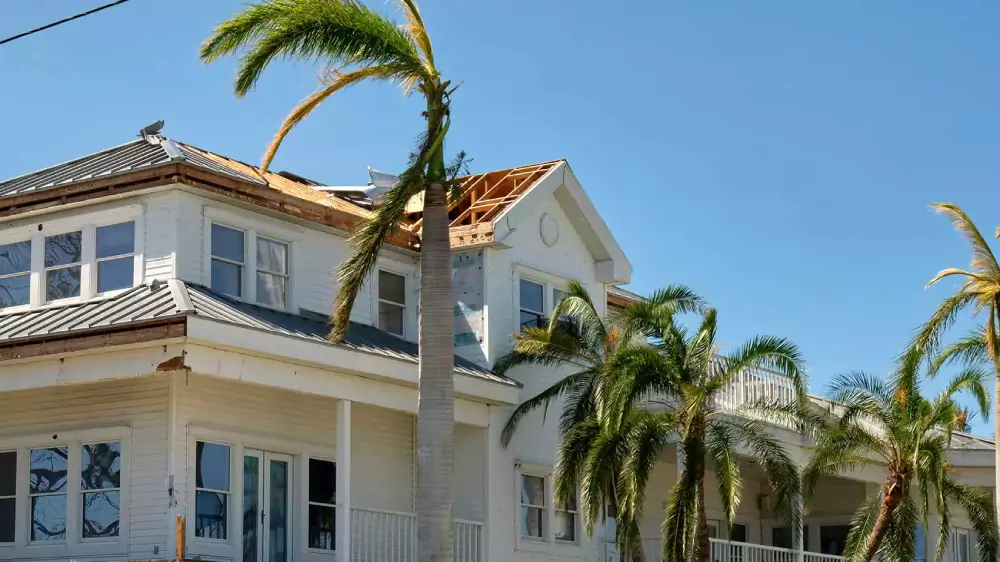
Hurricanes are most likely to do the most damage in Florida, Texas, and Louisiana, where hurricanes happen the most. On average, approximately 1.75 hurricanes strike the U.S. each year.
Hurricanes are the most expensive weather disasters in the U.S., racking up more than $1.3 trillion in damages since 1980. That’s an average price tag of $22.8 billion per hurricane disaster.
Where do hurricanes hit the most? What type of damage can occur, and, most importantly, how can property owners take proactive measures?
Where Do Hurricanes Happen the Most?
Florida experiences the most hurricanes in the U.S. overall, with a total of 120 hurricanes from 1851 to 2022. In general, the Gulf Coast states (Florida, Texas, Louisiana) are the most susceptible to hurricanes, followed by East Coast and mid-Atlantic states.
| State | Category 1 | Category 2 | Category 3 | Category 4 | Category 5 | All |
|---|---|---|---|---|---|---|
| 1. Florida | 47 | 36 | 24 | 11 | 2 | 120 |
| 2. Texas | 29 | 16 | 12 | 7 | 0 | 64 |
| 3. Louisiana | 24 | 20 | 13 | 5 | 1 | 63 |
| 4. North Carolina | 32 | 19 | 6 | 1 | 0 | 58 |
| 5. South Carolina | 18 | 9 | 2 | 3 | 0 | 32 |
| 6. Alabama | 12 | 6 | 5 | 0 | 0 | 23 |
| 7. Georgia | 14 | 4 | 2 | 1 | 0 | 21 |
| 8. New York | 9 | 3 | 3 | 0 | 0 | 15 |
| 9. Mississippi | 3 | 5 | 5 | 0 | 1 | 14 |
| 10. Virginia | 11 | 2 | 0 | 0 | 0 | 13 |
To compile the top 10 states hit most often by hurricanes, we analyzed National Oceanic and Atmospheric Administration (NOAA) data on U.S. hurricane landfalls from 1851 to 2022. “Major” hurricanes (Category 3 or higher on the Saffir-Simpson Hurricane Wind Scale) are particularly destructive and accounted for 92 out of 301 total landfalls during this period.
To estimate average hurricane damage costs per state, we looked at NCEI - NOAA data on tropical cyclone costs (1980-2021). We isolated hurricane data and cross-referenced it with state impact information from the NOAA to calculate an average cost per state over this period. While not an exact science, this approach provides a general picture of historical financial impact.
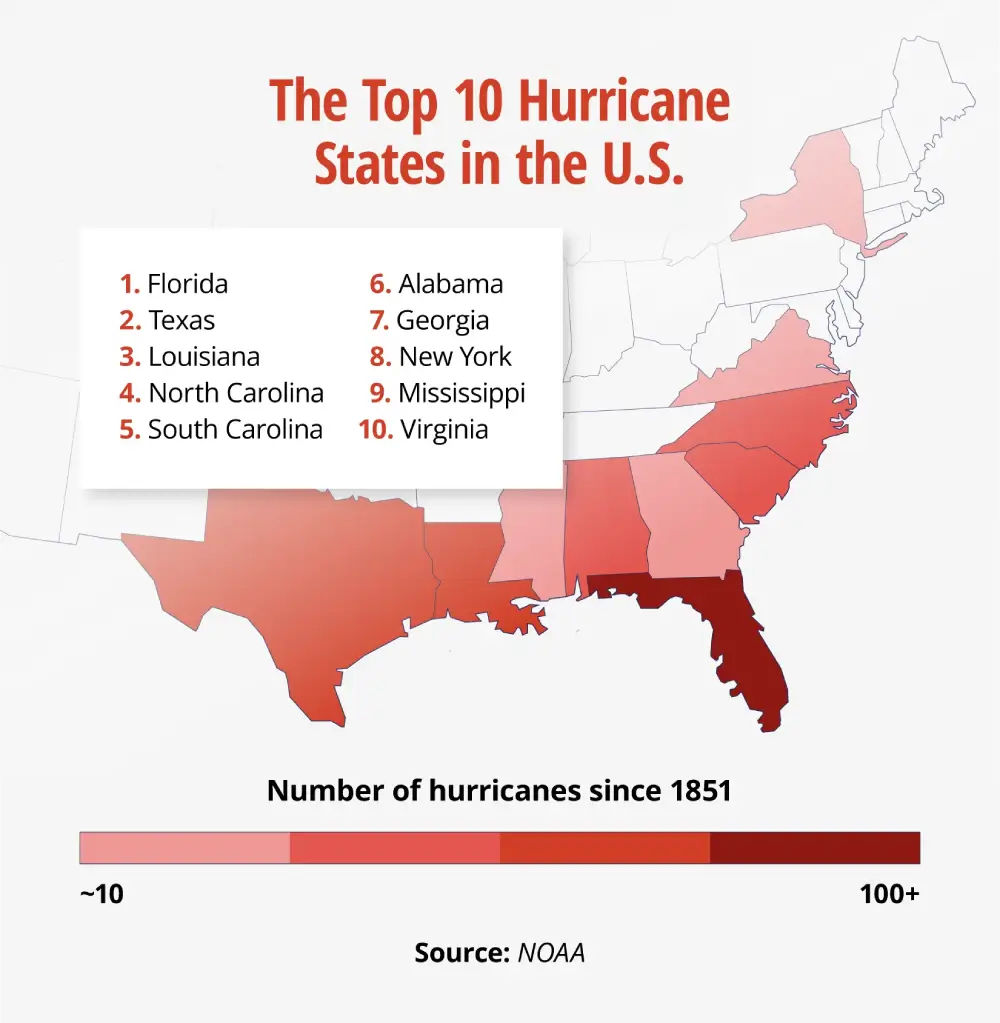
The Top 10 Hurricane States
This list explores the top 10 states impacted by hurricanes, detailing the frequency of landfalls, the types of damage these areas may experience, and the associated costs.
1. Florida
Number of hurricanes: 120
Most affected city: Miami
Most destructive hurricane: Hurricane Andrew (1992)
Florida’s position as a peninsula jutting out into warm Atlantic and Gulf waters makes it a bullseye for hurricanes. With no large landmasses to weaken them before landfall, these storms can reach the state with devastating force.
One of the most destructive hurricanes in Florida’s history was Hurricane Andrew in 1992, which slammed into southern Miami with Category 5 winds. It caused significant destruction, financial damage, and forever changed building codes in the state.
Average Cost of Damage
Average cost per hurricane: $23.6 billion
Hurricanes inflict the most financial costs through property damage. Homes, businesses, and infrastructure can all be severely impacted by wind, storm surge, and flooding. In 2022, Florida had its most expensive year, with $116 billion in hurricane damages.
2. Texas
Number of hurricanes: 64
Most affected city: Galveston
Most destructive hurricane: Galveston Hurricane (1900)
Texas’ lengthy coastline along the Gulf of Mexico makes it a target for hurricanes. The biggest dangers come from a combination of powerful storm surges flooding low-lying areas, especially along the upper coast, and destructive winds that can cause widespread power outages and devastation to structures.
While Hurricane Harvey brought historic flooding to Texas, it pales in comparison to the devastation of the 1900 Galveston Hurricane. This earlier storm unleashed a massive 15.7-foot storm surge. This surge, coupled with the city’s lack of preparedness and weaker infrastructure, caused a far greater tragedy than Hurricane Harvey and a rebuilding effort that greatly altered Galveston’s landscape.
Average Cost of Damage
Average cost per hurricane: $5.9 billion
Texas faces storm surge flooding and wind damage as the costliest types of damage due to hurricanes. Strong hurricane winds in Texas can cause significant damage to roofs, siding, power lines, and trees.
3. Louisiana
Number of hurricanes: 63
Most affected city: New Orleans
Most destructive hurricane: Hurricane Katrina (2005)
Louisiana’s position in the “Hurricane Alley” of the Gulf Coast makes it a prime location for hurricanes. Its low-lying coastal areas are particularly vulnerable to storm surges, and the state’s extensive network of marshes and swamps provides minimal natural protection against storm impacts.
One of the state’s most destructive and costliest natural disasters was Hurricane Katrina, which struck in 2005, overwhelming New Orleans’ levee system and resulted in devastating flooding.
Average Cost of Damage
Average cost per hurricane: $24.8 billion
The anticipated financial toll of hurricane damages in Louisiana averages $107 per resident. The state also witnessed the most expensive hurricane in the U.S., Hurricane Katrina, which accounted for $186.3 billion in damages.
4. North Carolina
Number of hurricanes: 58
Most affected city: Cape Hatteras
Most destructive hurricane: Hurricane Floyd (1999)
North Carolina’s jutting coastline puts it squarely in the path of hurricanes forming in the Atlantic. Nicknamed the “Outer Banks,” these barrier islands offer some protection for the mainland but also experience the full brunt of a storm’s fury.
In 1999, Hurricane Floyd unleashed record-breaking floods. Property damages amounted to almost $6 billion, while farm losses due to paused agricultural production cost more than $1 billion.
Average Cost of Damage
Average cost per hurricane: $26.9 billion
The most expensive culprit is storm surge flooding. This saltwater inundation devastates coastal communities, destroying homes, businesses, and infrastructure.
5. South Carolina
Number of hurricanes: 32
Most affected city: Charleston
Most destructive hurricane: Hurricane Hugo (1989)
South Carolina’s East Coast location plus its low-lying geography with barrier islands means storm surge is a major threat. Its most iconic hurricane, Hugo in 1989, hit the state as a Category 4 storm with the highest storm tide heights ever recorded on the U.S. East Coast, around 20 feet, and caused about $7 billion in damage.
Average Cost of Damage
Average cost per hurricane: $3.5 billion
Flooding from heavy rain causes the most property damage in South Carolina. For example, Hurricane Florence in 2018 dropped record-breaking rainfall, exceeding 20 inches in some areas. It’s estimated that the storm caused more than $1.2 billion in damages.
6. Alabama
Number of hurricanes: 23
Most affected city: Mobile
Most destructive hurricane: Hurricane Katrina (2005)
Alabama’s long coastline stretches directly into the Gulf of Mexico, lacking the protection of barrier islands or jutting landmasses that could deflect storms. Though it made initial landfall in Louisiana, Hurricane Katrina’s storm surge and relentless rain caused catastrophic flooding across Alabama in 2005.
Average Cost of Damage
Average cost per hurricane: $15 billion
Flooding from heavy rains of hurricanes passing through the Gulf is one of the main types of hurricane damage in Alabama. Additionally, Alabama’s coastal regions are highly vulnerable to strong winds that can rip off roofs, shatter windows, and topple trees and power lines.
7. Georgia
Number of hurricanes: 21
Most affected city: Marietta
Most destructive hurricane: Hurricane Floyd (1999)
Georgia’s geographic location makes it vulnerable to hurricanes, though not quite to the same degree as Florida. Since its coastline juts eastward, it partially deflects some storms that travel north along the Florida peninsula. However, the state remains exposed to hurricanes that take a more westerly track through the Gulf of Mexico.
The most dangerous aspect for Georgia is heavy rainfall, which can trigger flash floods and mudslides that can pose a serious threat — even far inland. Hurricane Floyd in 1999, for instance, didn’t make landfall directly in Georgia, but Floyd’s deluge caused devastating floods.
Average Cost of Damage
Average cost per hurricane: $1.2 billion
Property damage from hurricanes stands out as a primary expense, however economic repercussions due to agriculture losses have had a big impact on the state. For example, Hurricane Michale caused over $2 billion in losses to Georgia’s agriculture industry, due to damage to crops such as pecan trees and cotton fields.
8. New York
Number of hurricanes: 15
Most affected city: New York City
Most destructive hurricane: Hurricane Sandy (2012)
New York’s location on the Atlantic Coast puts it at risk, especially from storms that take a more northeasterly path. Long Island and coastal areas are particularly vulnerable to storm surges, which can cause devastating flooding.
In 2012, Hurricane Sandy brought a brutal combination of strong winds, storm surge, and heavy rain that caused widespread damage throughout the state, particularly in New York City and Long Island.
Average Cost of Damage
Average cost per hurricane: $1.7 billion
Storm surges cause the most damage in New York. Hurricane Sandy alone caused damages estimated at $19 billion. The saltwater intrusion caused extensive damage to buildings and infrastructure, requiring massive rebuilding efforts.
9. Mississippi
Number of hurricanes: 14
Most affected city: Biloxi
Most destructive hurricane: Hurricane Katrina (2005)
Mississippi’s location along the Gulf of Mexico and low-lying terrain is particularly vulnerable to storm surges, which can lead to extensive flooding and erosion. The state’s dense population centers such as Biloxi and Gulfport face heightened risks of wind damage and infrastructure destruction during hurricanes.
For example, Hurricane Katrina’s powerful winds and storm surge caused extensive flooding across Mississippi in 2005, even though it made landfall in Louisiana.
Average Cost of Damage
Average cost per hurricane: $4.8 billion
Similar to its neighboring states, hurricanes in Mississippi can be very expensive due to storm surge flooding. The powerful winds of a hurricane can push a massive wave of seawater inland, inundating coastal areas. This can cause devastating property damage, flooding homes and businesses with saltwater, leading to structural issues, ruined furniture, and the need for extensive repairs or even complete reconstruction.
10. Virginia
Number of hurricanes: 13
Most affected city: Virginia Beach
Most destructive hurricane: Hurricane Isabel (2003)
Coastal areas of Virginia, especially in the Chesapeake Bay region, are ground zero for storm surge. While hurricane winds in Virginia may not be the strongest, they can still damage infrastructure and knock out power for extended periods.
The state’s most destructive hurricane was Isabel in 2003. Its powerful winds and surge caused the most damage along the coast and in Hampton Roads.
Average Cost of Damage
Average cost per hurricane: $4.2 billion
The most common and costly type of hurricane damage in Virginia is inland flooding. While storm surge flooding is still a threat, it’s less prominent since the coastline isn’t as extensively exposed as states further south. For example, Hurricane Isabel in 2003 caused devastating inland flooding across much of Virginia, amounting to $1 billion in damage.
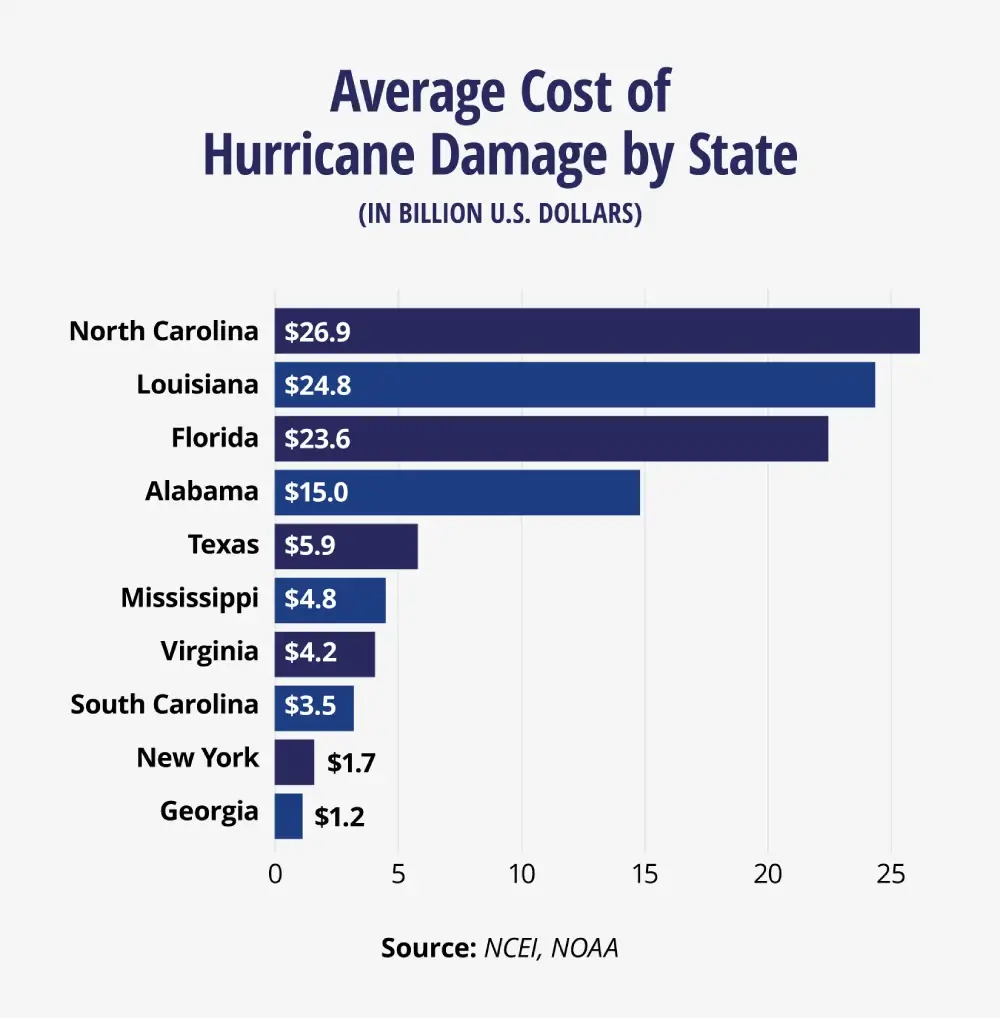
The 5 Most Destructive Hurricanes in U.S. History: Where Did They Hit?
Here’s a look at the five most destructive hurricanes to ever hit the U.S., including where they had the most impact and the total repair costs of these severe weather events.
- Hurricane Katrina: This Category 5 storm struck Louisiana, Mississippi, and Alabama. While the levees in New Orleans were designed to withstand Category 3 storms, Katrina’s surge overwhelmed them, leading to catastrophic flooding and destruction. Repair costs ballooned to over $170 billion.
- Hurricane Maria: Catastrophic winds and torrential rain from this Category 5 storm caused widespread landslides, power outages, and building collapse in Puerto Rico and the U.S. Virgin Islands in 2017. The estimated repair costs in Puerto Rico alone topped $100 billion.
- Hurricane Sandy: The Category 3 storm, unique due to its size, hit the northeastern U.S. mid-Atlantic coast. A combination of storm surge, high tides, and river flooding devastated coastal communities in New York, New Jersey, and Connecticut. Reconstruction costs were estimated at over $74 billion.
- Galveston Hurricane: This Category 4 hurricane slammed into Texas, particularly Galveston Island, in 1900. The storm destroyed most of the city’s buildings and infrastructure, leading to repairs exceeding $20 million to $30 million in today’s currency.
- San Felipe-Okeechobee Hurricane: Also known as the Lake Okeechobee Hurricane, this Category 5 storm devastated Florida in 1928. A deadly combination of wind and surge caused massive flooding, particularly around Lake Okeechobee in Florida. The storm’s total repair costs are estimated at $16 billion today.
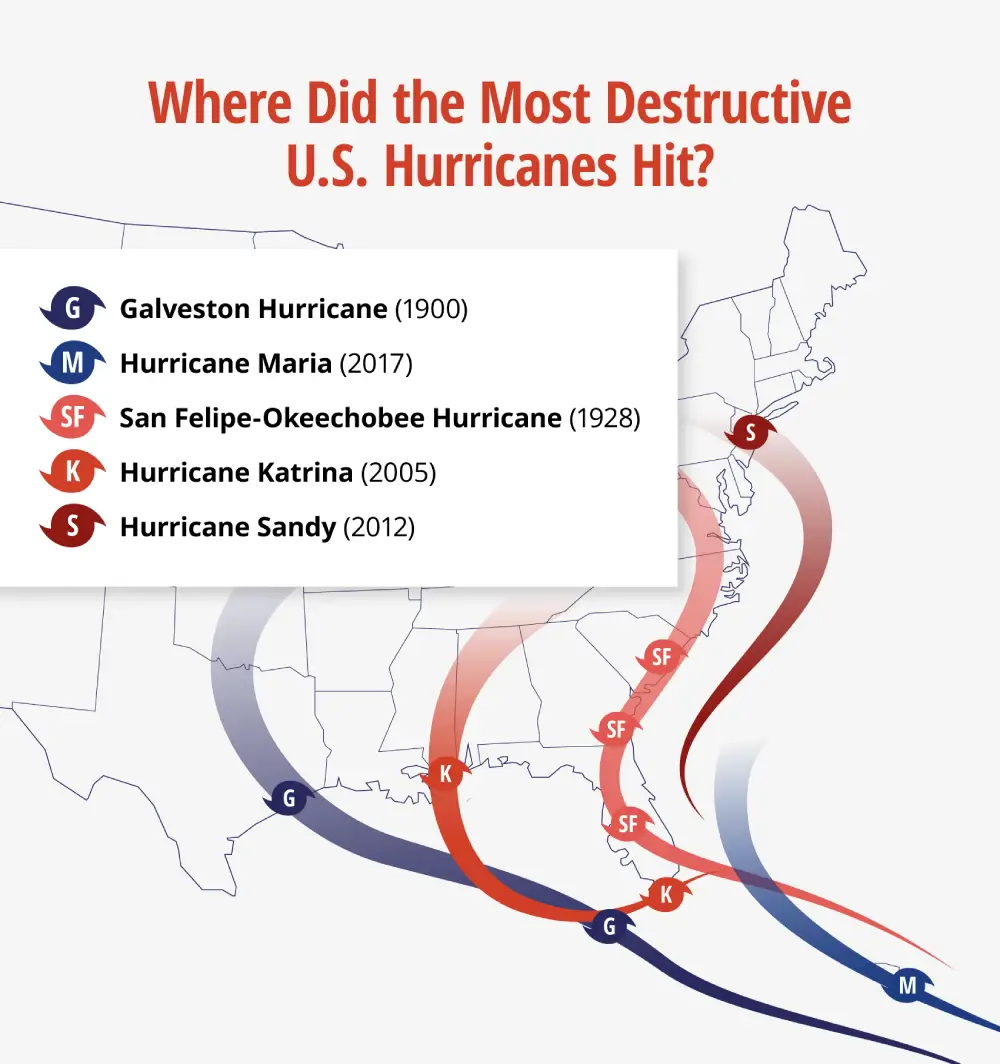
When Are Hurricanes Most Common?
While hurricane season in the U.S. depends on the coast, hurricanes are most common from August through October:
- Atlantic and Gulf Coast: The Atlantic hurricane season officially runs from June 1 to November 30, with peak activity typically around mid-August to late October.
- Pacific Coast: The Pacific Coast experiences a less frequent hurricane threat than the Atlantic. The Eastern Pacific hurricane season takes place from May 15 to November 30, while the Central Pacific hurricane season occurs from June 1 to November 30.
What Type of Damage Do Hurricanes Cause?
Hurricane damage to residential and commercial properties is caused by sustained wind, rain, and storm surge. A hurricane’s aftermath often involves widespread destruction and significant financial loss.
- Wind damage: Category 2 hurricanes (96-110 mph) can cause significant damage to buildings, uproot trees, and lead to widespread power outages. Category 3 hurricanes and higher (111 mph and above) unleash destructive winds capable of toppling trees, tearing off roofs, and causing structural damage to buildings and infrastructure.
- Storm surge: One of the most dangerous aspects of hurricanes, storm surges can inundate coastal areas with a rapid rise in water level, leading to flooding and erosion of shoreline properties.
- Flooding: Hurricanes cause heavy rainfall, which leads to flooding, overwhelming drainage systems, and submerging buildings, roads, and farmland.
- Tornado damage: Hurricanes often spawn tornadoes, particularly in their outer bands, which can cause localized but severe damage to structures and vegetation.
- Debris impact: Flying debris propelled by hurricane-force winds poses a significant hazard, damaging buildings, vehicles, and infrastructure.
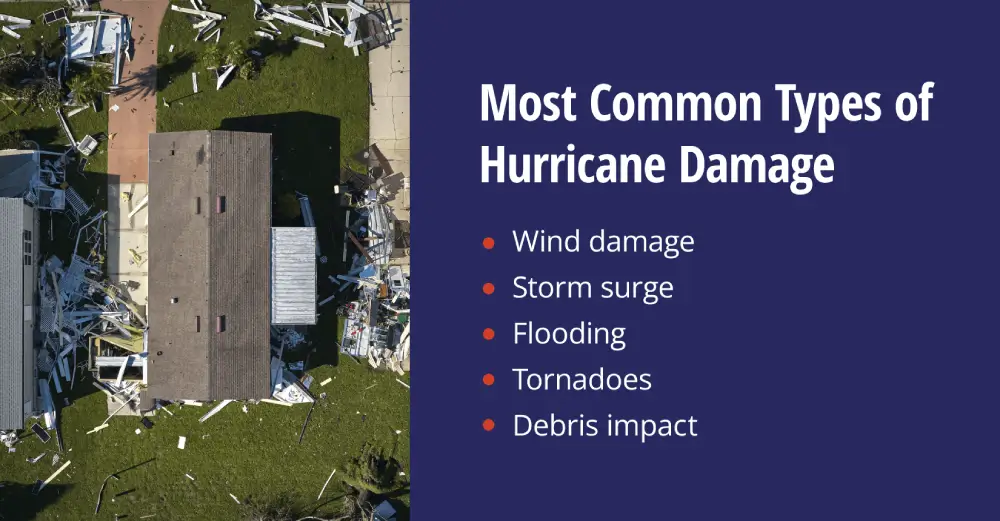
Protective Measures for Hurricane Preparedness
Preparing for hurricanes involves a combination of proactive measures to mitigate potential damage. Here are some precautions to consider for those with properties in hurricane-prone areas:
- Hurricane windows: Installing hurricane-resistant windows involves upfront costs for purchasing and installation, but they offer long-term protection against high winds and flying debris to minimize damage risks.
- Roll-down shutters: Roll-down shutters provide convenient and quick protection for windows and doors.
- Accordion shutters: Accordion shutters are designed to withstand strong winds and flying debris and reduce wind pressure on your home, minimizing the risk of roof failure. They’re more visible than roll-down shutters when not in use and are only available in manual operation.
- Hurricane impact sliding door: Upgrading to a hurricane impact sliding door can enhance structural integrity and protect against wind and water intrusion.
- Hurricane panels: Hurricane panels help to prevent wind-driven rain from entering your home, which can help minimize water damage and mold growth.
- Hurricane garage door: Reinforcing or replacing the garage door with a hurricane-resistant option is essential for protecting this vulnerable entry point.
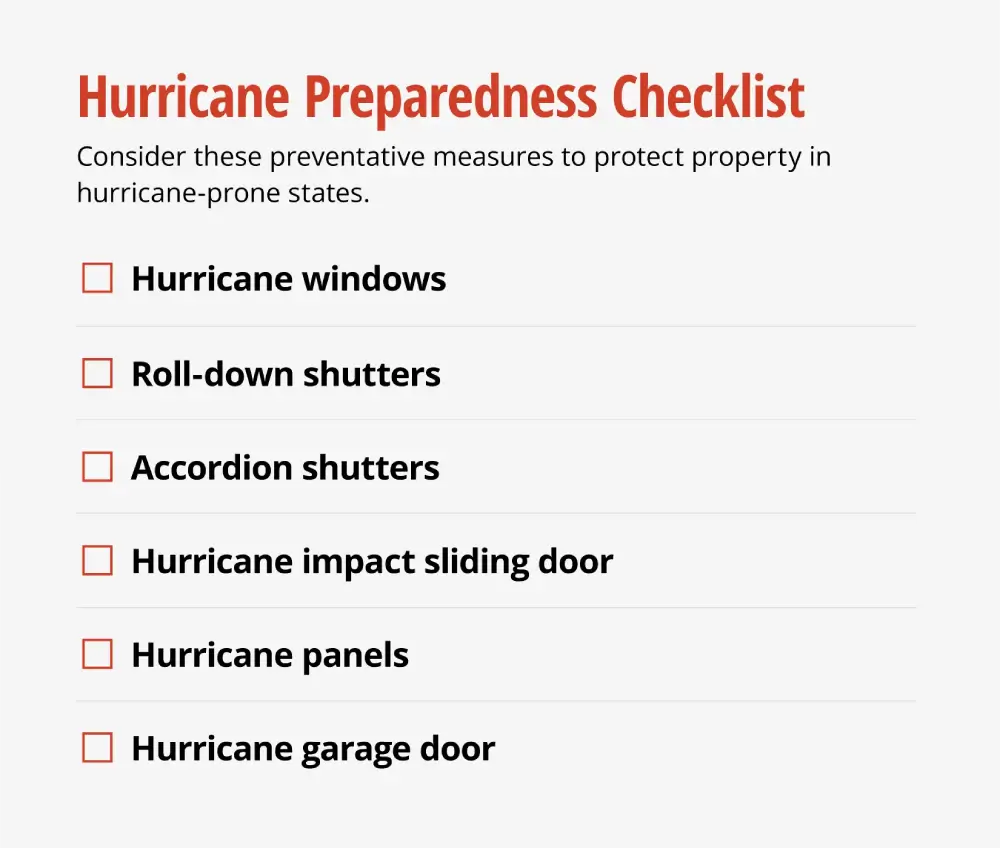
Trust Rainbow Restoration for Storm Damage Restoration
Knowing where hurricanes are most likely to do the most damage is just the first step. Proactive measures like formulating emergency plans, making disaster preparedness kits, and knowing a reliable restoration company are also important. When disaster strikes, don’t navigate the recovery process alone. Rainbow Restoration can help with storm damage restoration so property owners can focus on getting back on track after a storm.

FAQ
Where Is Most at Risk for Hurricanes?
Coastal regions, especially those bordering large bodies of water, are most at risk for hurricanes. This includes areas along the United States Gulf Coast, the Caribbean islands, and parts of East Asia.
Where Would a Hurricane Most Likely Form?
Hurricanes typically form over warm ocean waters, particularly in tropical or subtropical regions. The Atlantic Ocean, the eastern Pacific Ocean, and the Indian Ocean are common areas where hurricanes originate.
What Region Is Most Vulnerable to Hurricanes?
Regions prone to hurricanes vary but generally include coastal areas and islands in tropical and subtropical climates. The Caribbean, the Gulf of Mexico, and the Southeastern United States are among the most vulnerable regions due to their location and climate conditions.
What Is the Most Damaging Part of a Hurricane?
The most damaging part of a hurricane is often its eyewall, where the strongest winds and heaviest rainfall occur. The combination of high winds and intense precipitation can cause widespread damage to infrastructure and property.
What Kinds of Property Damage Do Hurricanes Cause?
The property damage caused by hurricanes varies greatly depending on factors like the storm’s intensity, path, and preparedness for severe storms. Hurricanes can significantly damage homes, commercial buildings, roads, and other infrastructure.
This article is intended for general informational purposes only and may not be applicable to every situation. You are responsible for determining the proper course of action for your property. Services should be performed by licensed and experienced professionals. Rainbow Restoration is not responsible for any damages that occur as a result of this blog content or your actions. For the most accurate guidance, contact a Rainbow Restoration professional for a custom, on-site assessment.
